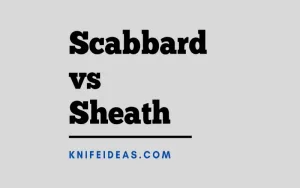Scabbard vs Sheath 2023 – What’s the Difference?
by Joshua Speaks
Many people explain scabbard vs sheath as different terms with similar meanings that can be used interchangeably. But that is not the case sheath is the most older version of blade cover used in Europe, later a German term was introduced and included in the English language, known as the scabbard.
The scabbard is mostly used in reference to weapons or weapon blades like daggers, swords, and axes, while the sheath is used in the broader spectrum, it shadows nearly all the blade covers.
Although both terms are used interchangeably by a common man, technically there is a difference between the two. Scabbards are complex in structure, rigid, and have a secondary compartment to provide more protection against accidental slips and erosions.
While the sheaths can be rigid and flexible, but it is specifically manufactured in one layer design that is not complex, you just need to cut the two material pieces and secure them together. Sheaths are the most widely and commonly used blade covers available in a variety of materials at low prices nowadays.
Also See: Best Machete Sheath
Scabbard vs Sheath
1. Defined in Reference to Weapon/ Blade:
Two terms are well defined by the blades they are associated with. Sheaths - the term is used for all sorts of blade covers, many say it as a knife cover or blade cover alternatively, while the term Scabbard is used for a long solid blade with sharp edges like a long dagger or a sword.
Well, talking about the broadness of the terminologies, "You can sheath your sword but you cannot scabbard your sword". Thus, if we say simply that the size and shape of the weapon will decide about the term to be used, we could not justify them then.
To elaborate, make an understanding that a sheath could be a scabbard but a scabbard cannot be a sheath. The difference lies in many other aspects too.
2. Difference In Material:
Scabbards are composed of hard rigid materials, commonly brass, wood leather, and in older times might of gold too. They are heavy in size and are composed multi-layered to protect the blade from causing any accidental hazard.
While the sheath is a lightweight covering, nowadays it is available made of leather, fabric, plastic, or even melamine. Sheaths are normally single-layered, flexible, and can't match the level of security provided by the scabbard to the blade.
In the older days, people used to wear scabbards using leather belts. Nowadays materials used to construct scabbards are relatively lesser in weight as compared to the ones available in older times.
3. The Difference in Manufacturing Process:
Sheaths are made in single-layer construction following a very simple method to cut out the size and sew them or punch them together. While scabbards are complex in construction.
They are made multiply layered, with all the layers being rigid. This multilayer concept is used in scabbard construction because the weapon will not be used daily and need to be protected from air and any knife of fluid that might cause corrosion in it.
This also increases the life of the weapon along with its protection. Moreover, a sheath construction could be rigid or flexible while the scabbard will essentially be rigid, it cannot be flexible.
4. The Difference in Manufacturing Cost
As described earlier, scabbards are made in layers and every layer is a rigid material (high-quality wood is most widely used as a scabbard construction material), and it needs a leather belt essentially to get fit around your shoulder or wrist, they have high manufacturing cost.
On the other hand, sheaths are the most widely and commonly used blade covers, even plastic sheaths are available in the market that cost just a few dollars.
Moreover, as the sheath is single-layered so the material consumption is also low, causing the manufacturing cost to decrease at the lowest. Hence, you can find cheap sheaths in the market but not the scabbards.
5. The Difference in Maintenance Cost:
Unarguably, scabbards have less maintenance cost because of the rigidity they have. Moreover, as the modern war era has changed and there is likely no chance of the human getting into the battlefield along that sharp edges, scabbards are exposed less, in turn, maintenance cost is minimal.
On contrary, the sheath is widely and roughly used, and if it is flexible too then the replacement and maintenance cost will be high.
6. The Difference in Required Time for Construction:
For the time required for the construction of two, whatever rigid material is used for the scabbard, you have to carve it carefully, you will not simply glue up the two pieces of wood.
You need a prototype and a construction that is hollow inside. This whole process is time-consuming while sheath can be made in relatively less time as the construction mechanism is simple.
7. The difference in Securing the Blade:
Scabbards are engineered for weapon blades, most widely said for a sword. They are made in compartments to provide insulation, and advanced protection against the outer environment, which includes gases and fluids. These gases and fluids can rust the blade, so protection against two is imperative.
Moreover, there is a secondary compartment for dual protection, it protects against accidental slipover too. While sheaths are manufactured following the blade for which they will be used.
For example, sheaths of regular knives are made of plastic or melamine on the other hand hunter's knife can have a wooden sheath.
The difference lies in the process of construction and here sheath lacks in providing the level of security that scabbard offers.
Conclusion: Scabbard vs Sheath

Well, scabbard vs sheath can be concluded as, although both are the blade covers and the names are used alternatively, the underlying difference is the construction process.
Sheath and scabbard are explained in reference to the blade they are used for. But trust me, it is not the size or shape of the blade nor the material of which two are made.
There is a huge difference in the process of manufacturing both. Hopefully, the above-mentioned article will clear your ambiguity and concepts related to scabbard vs sheath.

About Joshua Speaks
Can’t think of a day that that Josh didn’t have a beer or two. Be it a long day of work or of nothing. Sometimes, it is a few packs even. Especially when there are familiars over.
His fridge is packed with beers: Heineken, Corona, Guinness, Budweiser, and all other wierd brands in between. He had to get a secondary 30 cu. fridge off Craigslist for more beer storage.
Sometimes he wonders if a day truly starts only after the first sip of beer for the day. Enough talk about Josh and his passion; that’s the reason for this beer blog and related items. Feel free to hit on him. Start with something like: “hey beer head!” You got the idea!
Thoughts on "Scabbard vs Sheath 2023 – What’s the Difference?"
 |
 |
 |
 |
Kitchen - Outdoor